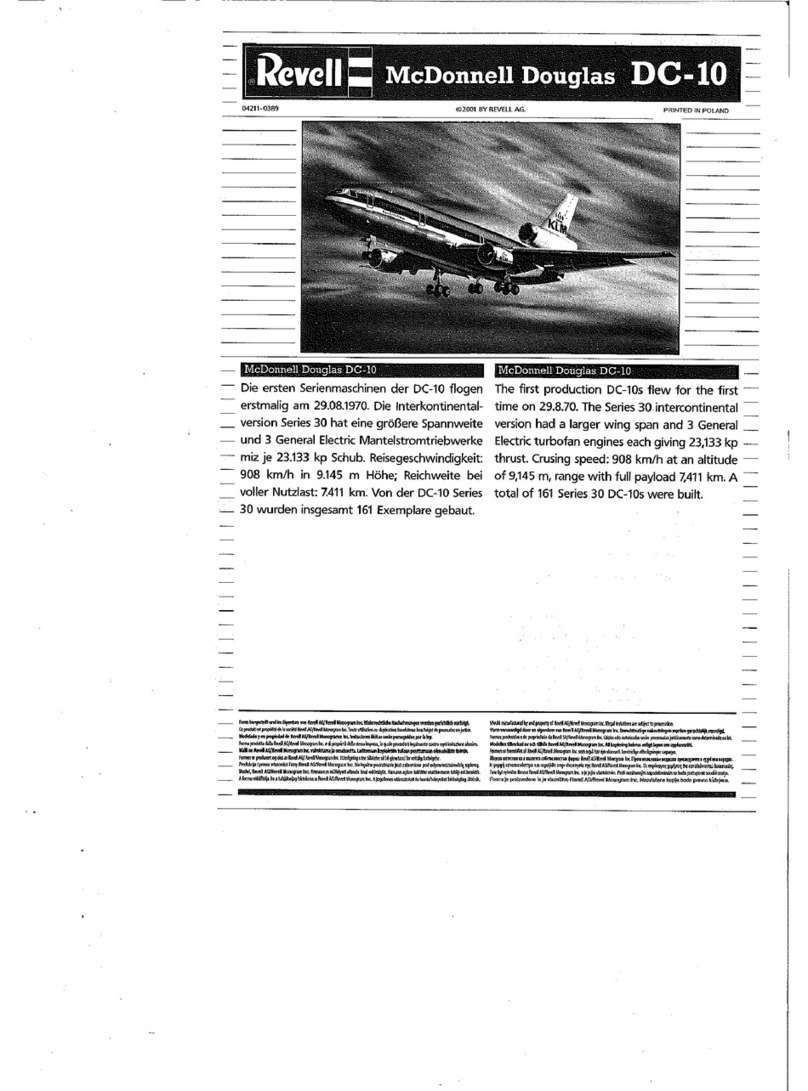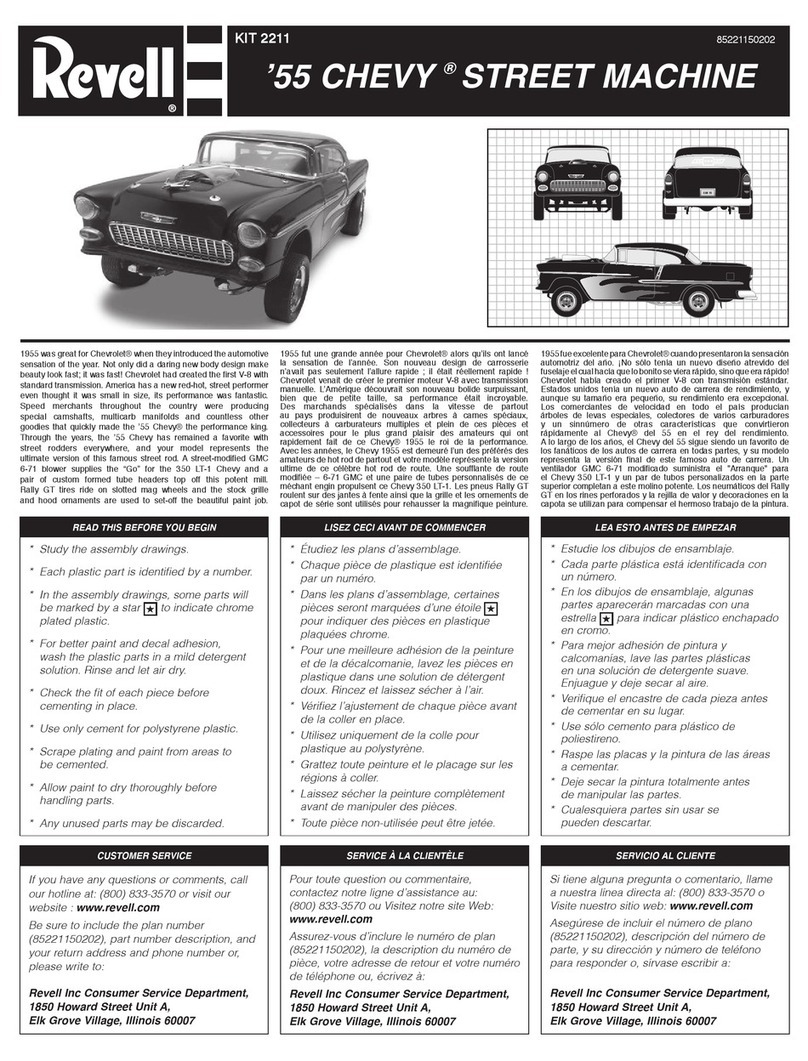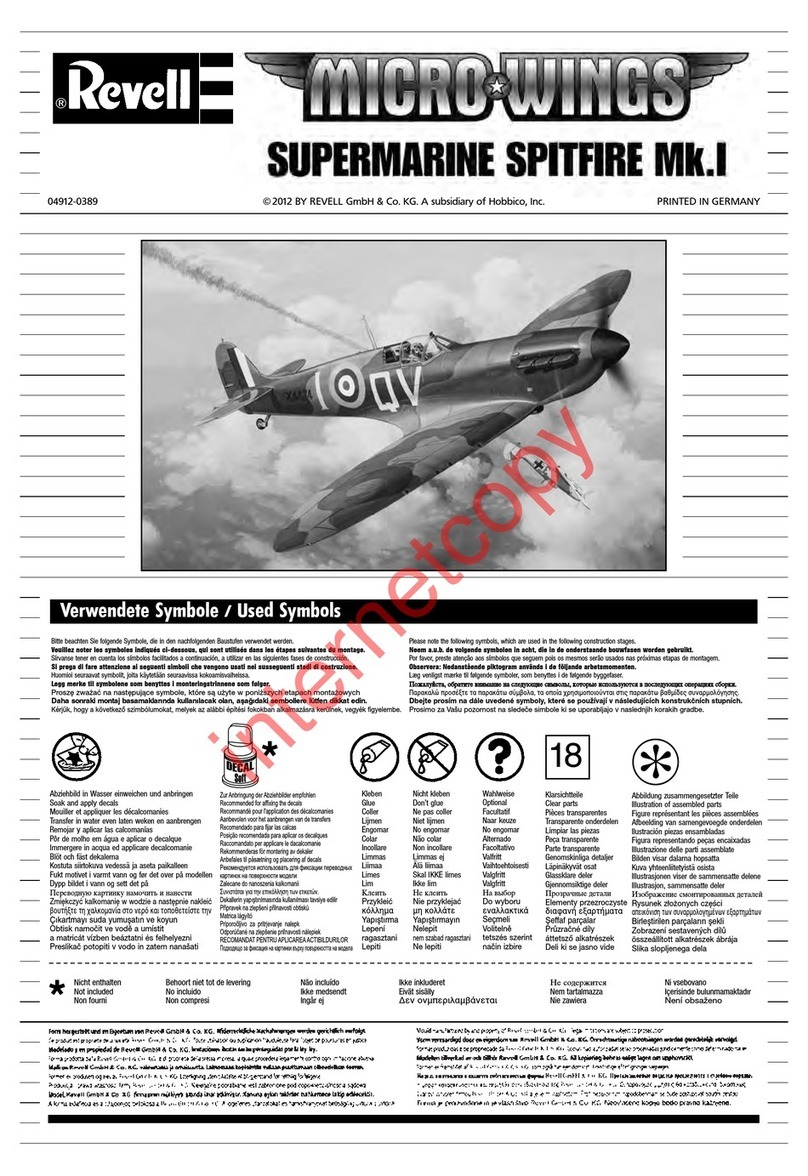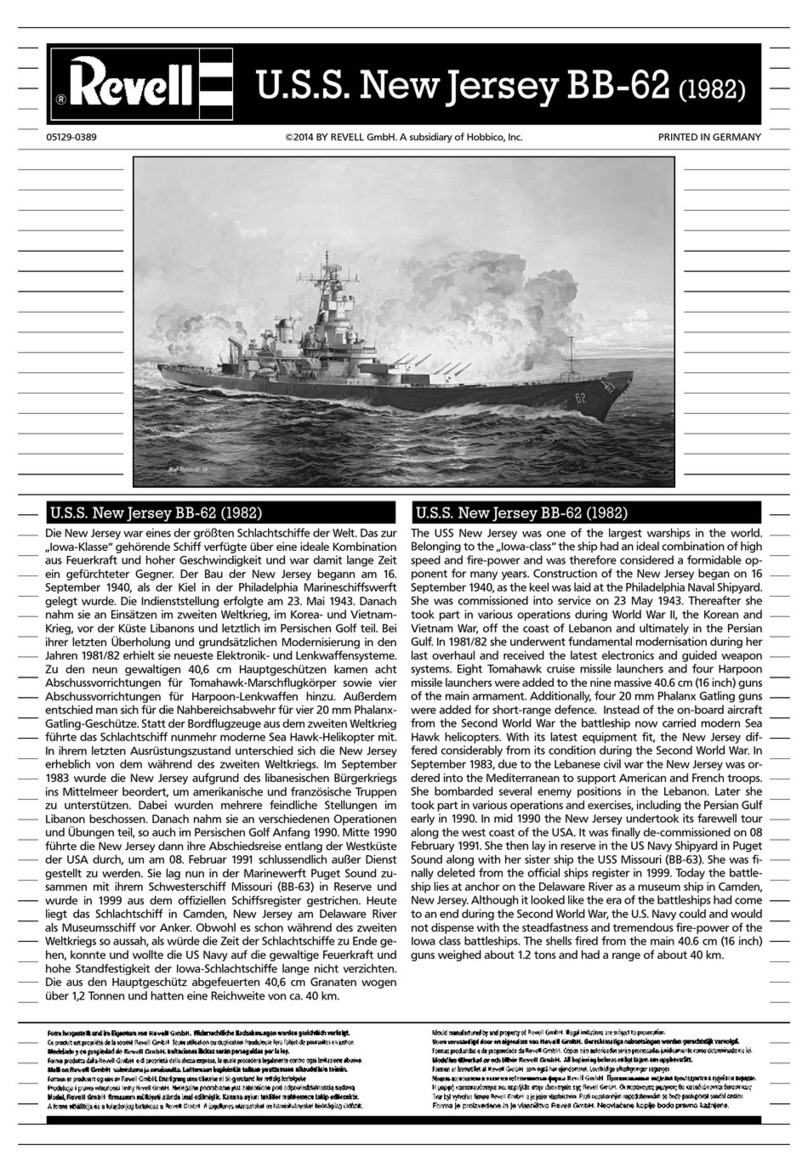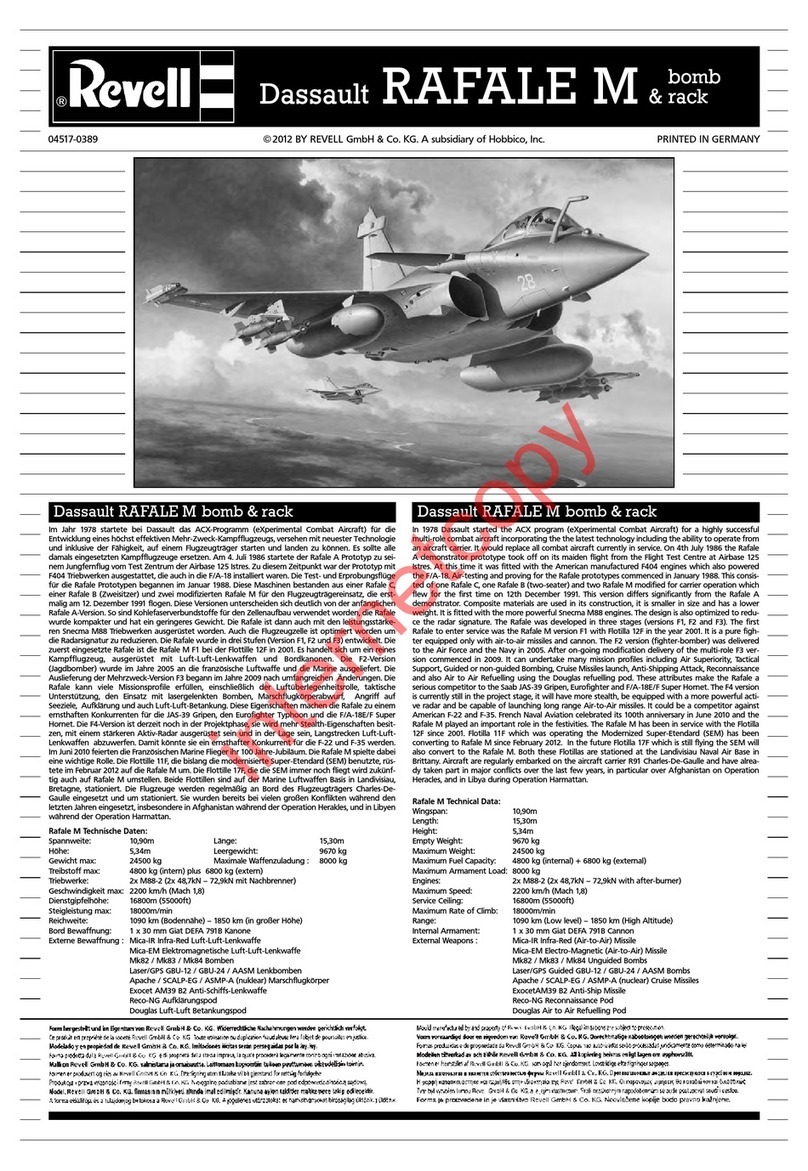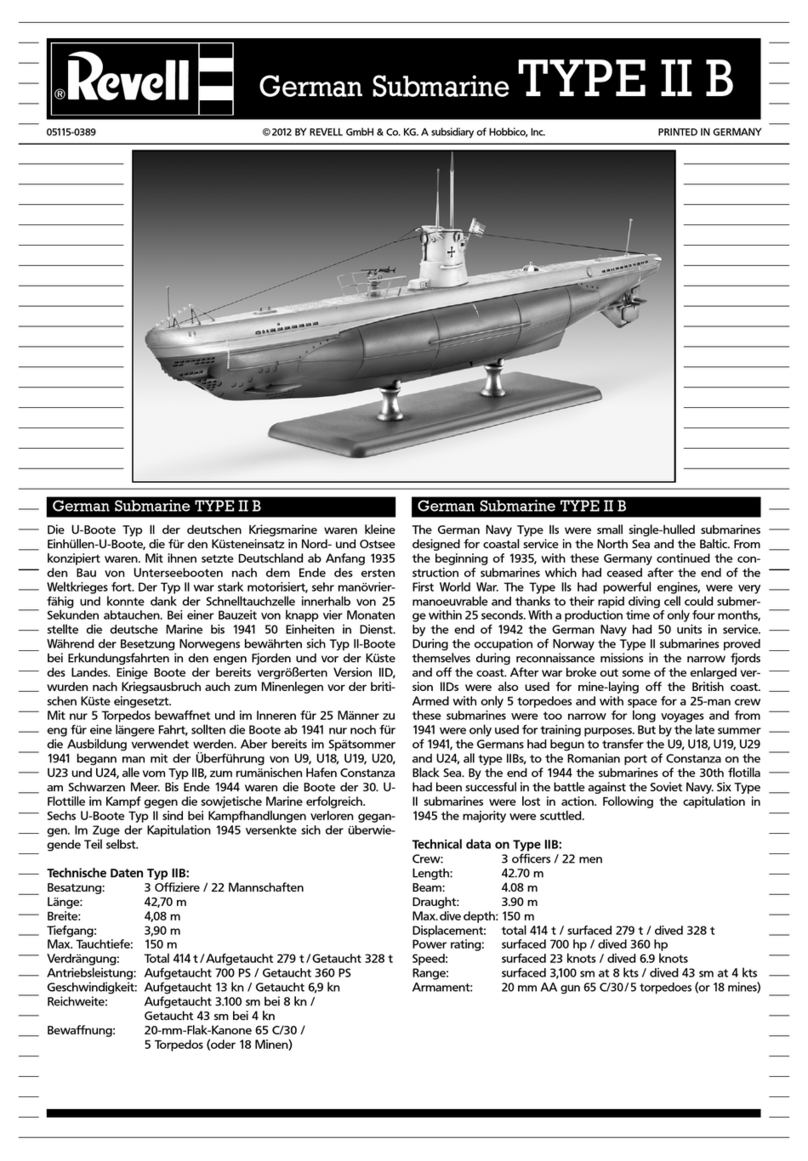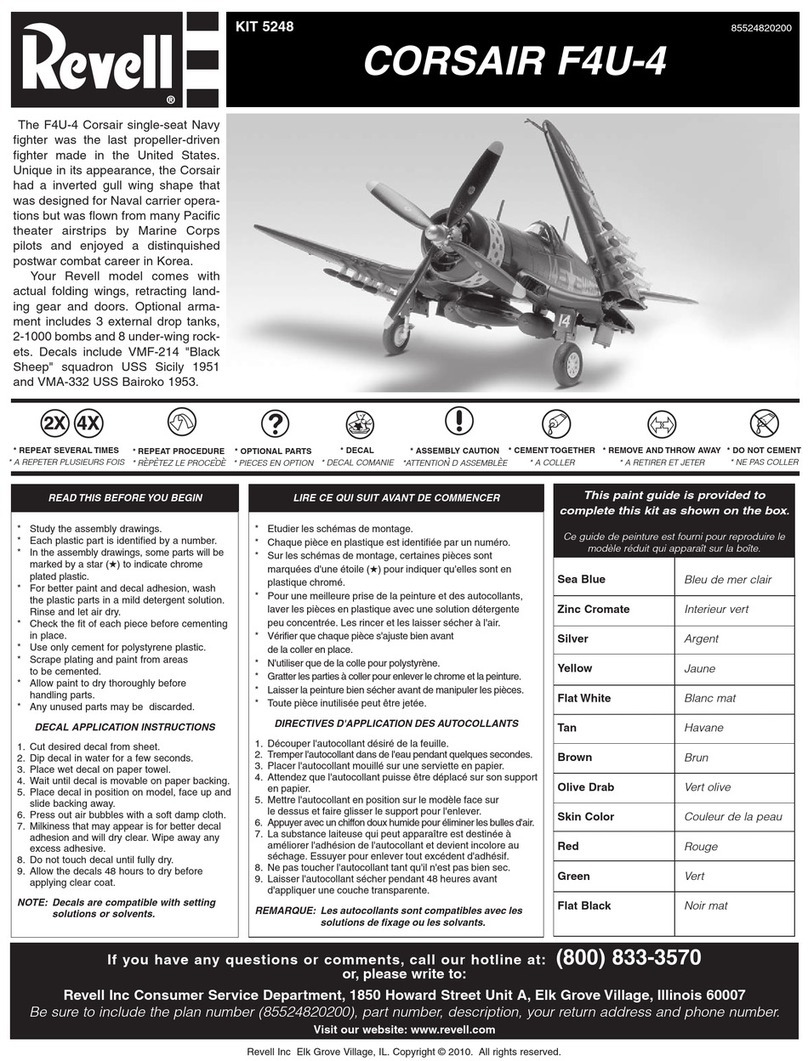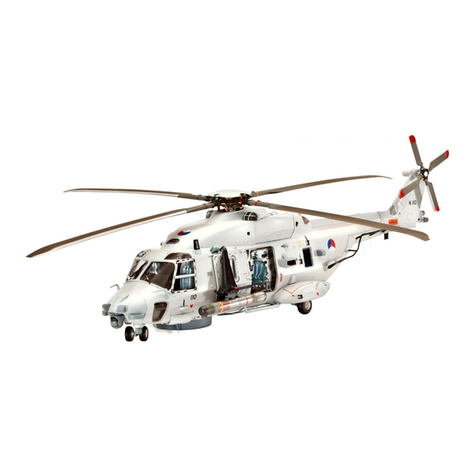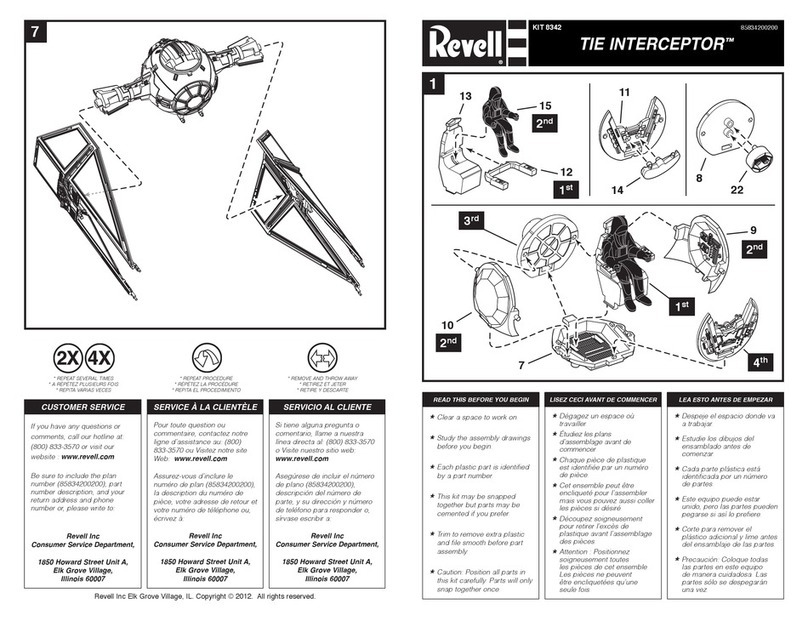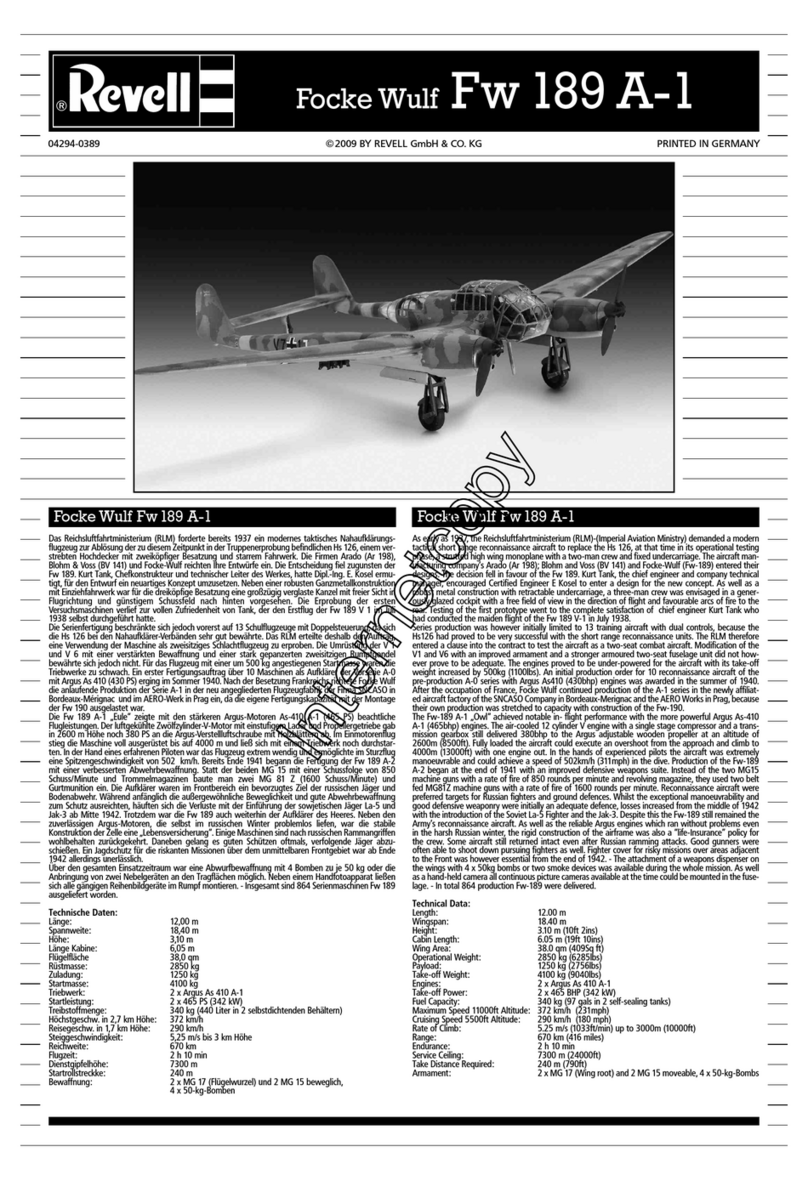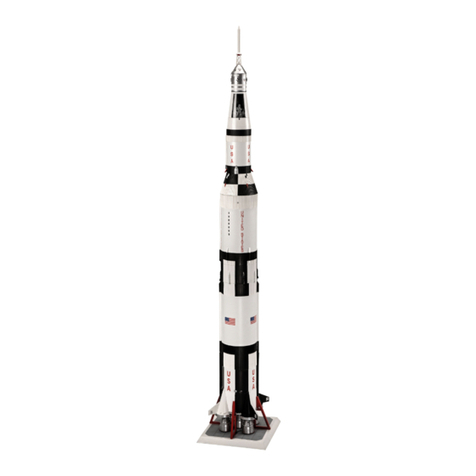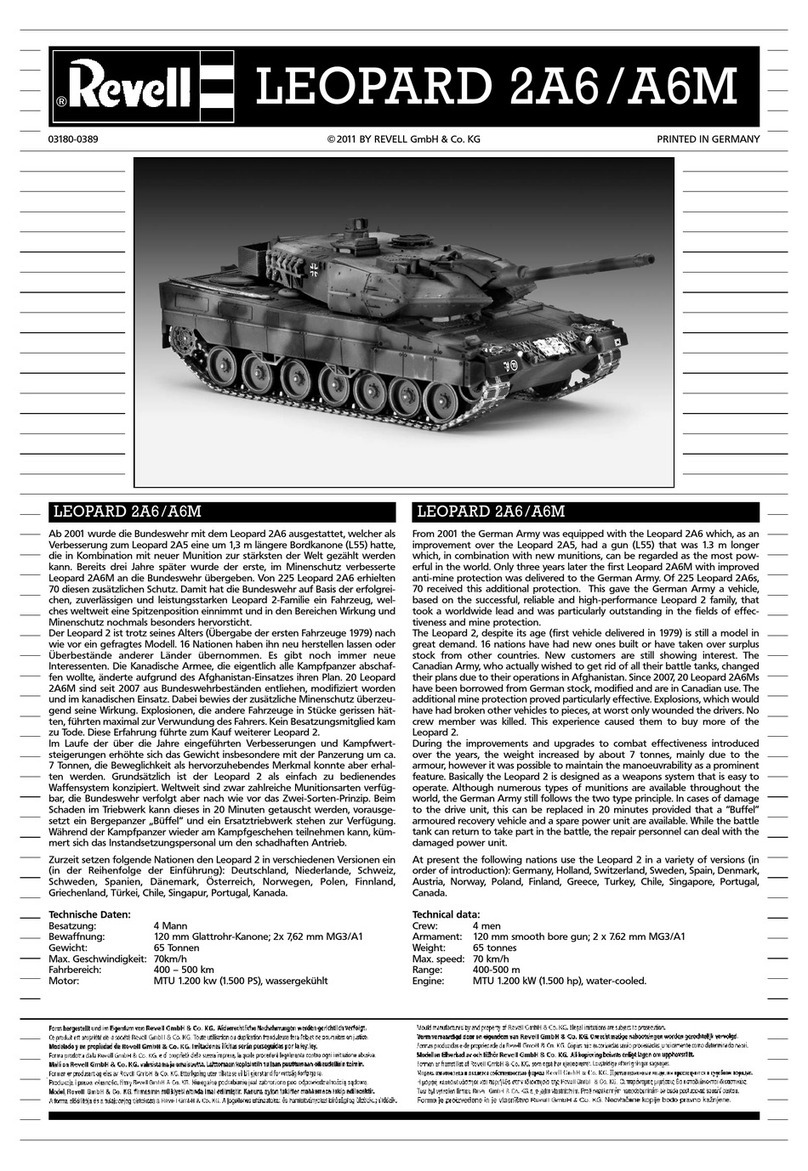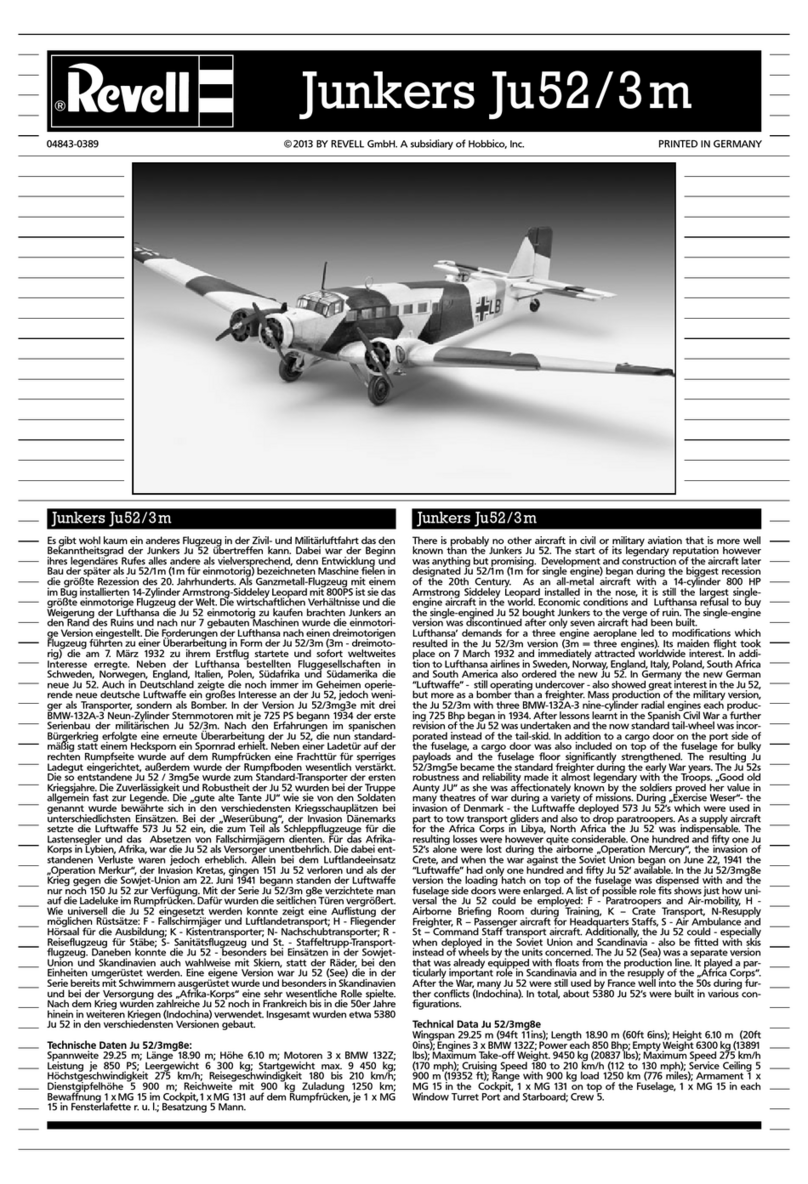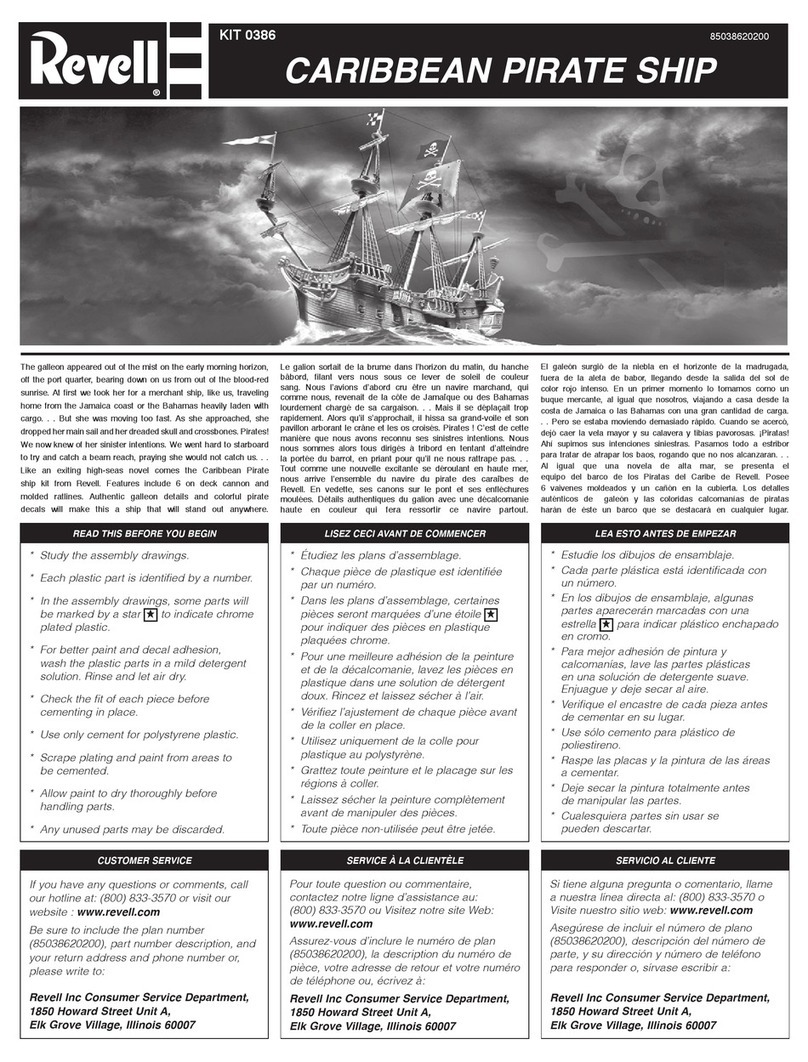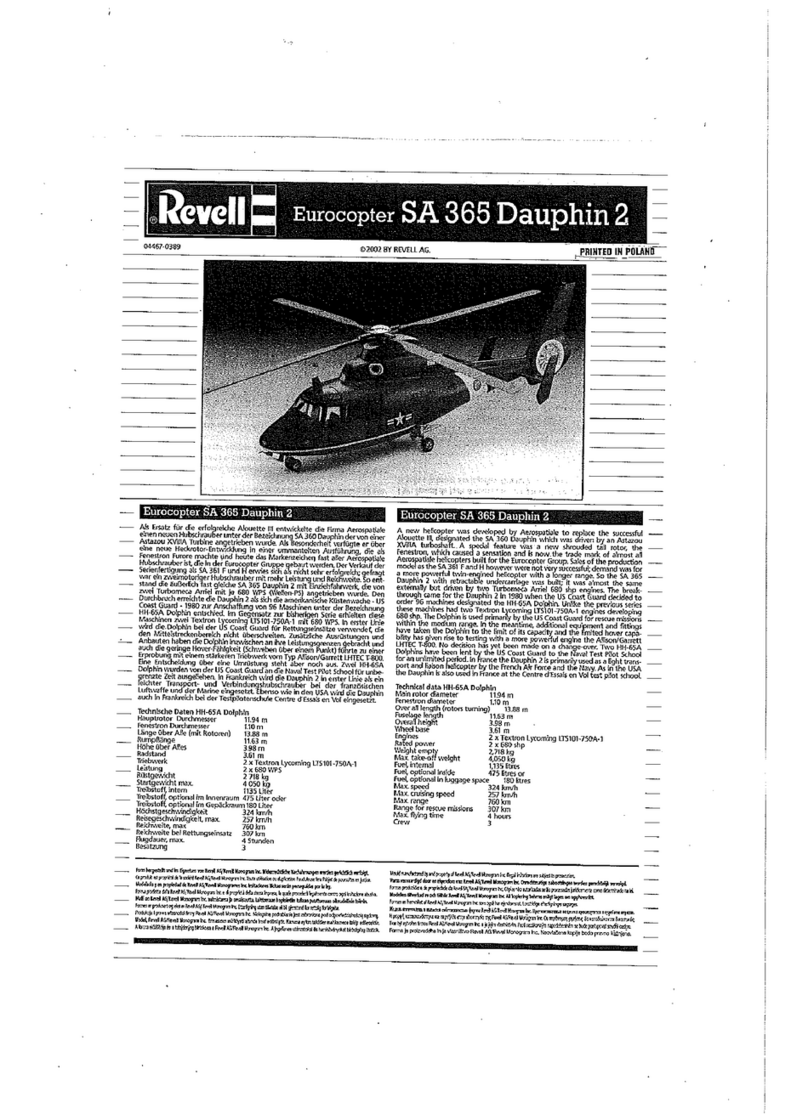2 3
• Cet avion convient aux enfants
de plus de 14 ans. La surveillance
des parents est nécessaire lors
du vol.
• Tenir à l’écart les mains, le visage,
les cheveux et les vêtements
amples de l’hélice.
• Eteindre la télécommande et l’avion
lorsqu’ils ne sont pas utilisés.
• Retirer les piles de la télécom-
mande lorsque celle-ci n‘est pas
utilisée.
• Toujours garder l’avion en vue an
de ne pas perdre le contrôle sur
celui-ci.
• Pour la télécommande, nous
recommandons l‘usage de piles
alcalines au manganèse. Pour
préserver l‘environnement, les
piles jetables de la télécommande
peuvent être remplacées par des
piles rechargeables (batteries).
• Changez les piles dès que la
télécommande ne fonctionne plus
parfaitement.
• Veuillez conserver ce mode
d‘emploi.
• L’utilisateur doit utiliser cet avion
uniquement conformément aux
consignes d’utilisation gurant
dans les présentes instructions de
service.
• Ne pas faire voler l’avion à proximité
des aéroports, des personnes, des
animaux, des plans d’eau et des
lignes électriques.
• La batterie NiMH de l’avion doit
toujours être chargée sur la télécom-
mande. Le processus de chargement
doit être soumis à une surveillance
constante et doit être interrompu
après 10 minutes maximum ou
lorsque la batterie chauffe.
• Éviter tout contact de l’avion avec
l’eau, sous peine d’endommager
ses composants électroniques.
• Toujours garder les yeux xés
sur l‘appareil, an d‘éviter qu‘il
ne percute et ne blesse le pilote,
d‘autres personnes ou des animaux.
• Cet appareil volant n’est pas adapté
aux personnes présentant des
facultés physiques ou mentales
réduites. Nous recommandons
aux personnes ne possédant
pas de connaissances dans les
maquettes d’avions la mise en
service sous la direction d’un
pilote expérimenté.
Entretien et soin :
• Nettoyer l’avion uniquement à
l’aide d’un chiffon propre.
• Protéger le modèle, la télécom-
mande et les piles de tout rayonne-
ment lumineux direct et/ou de
toute source de chaleur directe.
Consignes de sécurité concernant
les piles de la télécommande :
• Ne pas recharger les piles jetables.
• Les piles rechargeables doivent
être retirées de la télécommande
avant leur chargement.
• Les piles rechargeables doivent être
rechargées en présence d‘un adulte.
• Ne pas mélanger des piles de
type différent ou des piles neuves
et des piles usagées.
• Seules les piles recommandées
ou de même type peuvent être
utilisées.
• Respecter la polarité indiquée (+ et -)
lors de l‘insertion des piles.
• Les piles vides doivent être retirées
de la télécommande.
• Ne pas court-circuiter les bornes
de raccordement. Retirer les piles
de la télécommande si celle-ci
n‘est pas utilisée pendant une
période prolongée.
L’avion est équipé d’un accumu-
lateur Ni-MH. Veuillez respecter
les consignes de sécurité
suivantes :
• Ne jamais jeter les batteries dans
le feu, ne pas les conserver dans
des endroits chauds.
• Pour le chargement, utiliser
uniquement la télécommande
prévue à cet effet. L‘utilisation
d‘un autre chargeur peut endom-
mager durablement la batterie
ainsi que les composants qui la
jouxtent et causer des dommages
corporels !
• Toujours effectuer le chargement
sur une surface non inammable
et dans un environnement sécurisé
contre le feu.
• Surveiller la batterie du début à la
n du chargement.
• Ne jamais démonter ni modier
les contacts de la batterie. Ne
pas endommager ni percer les
cellules de la batterie. Il y a risque
d‘explosion !
• La batterie doit être maintenue
hors de portée des enfants.
• Lors de leur élimination, les bat-
teries doivent être vides ou leur
capacité de charge doit être nulle.
Recouvrir les pôles non protégés
de ruban adhésif an d‘éviter les
courts-circuits !
Consignes de sécurité :
• Ne jamais altérer la structure
de l‘appareil, sous peine de
l‘endommager ou de le rendre
dangereux.
• An d‘éviter les risques, ne jamais
se tenir en position assise (sur
le sol ou un siège) pour utiliser
l‘appareil. Commander l‘appareil
dans une position vous permettant
de l‘éviter rapidement si nécessaire.
• Toujours mettre hors tension
l‘appareil et la télécommande après
chaque utilisation. Dans le cas
contraire, un démarrage involontaire
pourrait avoir lieu.
D
• Achtung! Dieses Flugzeug ist kein
Spielzeug, sondern ein komplexes
Fluggerät, das bei unsachgemäßer
Handhabung Personen- und
Sachschäden verursachen kann.
Der Pilot ist für den gefahrlosen
Betrieb verantwortlich!
• Diese Anleitung muss vor Inbe-
triebnahme vollständig gelesen
und verstanden werden!
• Dieses Flugzeug ist für den
Gebrauch im Freien bei keinem
bis wenig Wind geeignet.
• Dieses Flugzeug ist ab 14 Jahren
geeignet. Die Aufsicht der Eltern
ist beim Fliegen erforderlich.
• Hände, Gesicht, Haare und lose
Kleidung vom Propeller fernhalten.
• Fernsteuerung und Flugzeug
ausschalten, wenn sie nicht im
Einsatz sind.
• Batterien aus der Fernsteuerung
nehmen, wenn sie nicht im
Einsatz ist.
• Das Flugzeug stets im Auge
behalten, um die Kontrolle nicht
zu verlieren.
• Wir empfehlen für die Fern-
steuerung neue Alkali-Mangan-
Batterien. Einwegbatterien für
diese Fernsteuerung können durch
auadbare Batterien (Akkumula-
toren) umweltfreundlich ersetzt
werden.
• Sobald die Fernsteuerung nicht
mehr zuverlässig funktioniert,
sollten neue Batterien eingelegt
werden.
• Diese Bedienungsanleitung bitte
aufbewahren.
• Der Benutzer sollte dieses Flugzeug
nur gemäß den Gebrauchshin-
weisen in dieser Bedienungsan-
leitung betreiben.
• Das Flugzeug nicht in der Nähe
von Flughäfen, Personen, Tieren,
Gewässern und Stromleitungen
iegen.
• Den NiMH-Akku des Flugzeugs
immer an der Fernsteuerung
laden. Den Ladvorgang immer
überwachen und spätestens nach
10 Minuten oder wenn der Akku
warm wird unterbrechen.
• Das Flugzeug niemals mit Wasser
in Verbindung bringen, da dadurch
die Elektronik beschädigt werden
kann.
• Das Fluggerät stets beobachten,
damit es nicht gegen den Piloten,
andere Menschen oder Tiere iegt
und sie verletzt.
• Generell ist darauf zu achten, dass
das Modell auch unter Berücksich-
tigung von Funktionsstörungen
und Defekten niemanden verletzen
kann.
• Dieses Fluggerät ist nicht geeignet
für Menschen mit körperlichen
oder geistigen Einschränkungen.
Personen ohne Kenntnisse im
Modellug empfehlen wir die
Inbetriebnahme unter Anleitung
eines erfahrenen Piloten.
Wartung und Pege:
• Das Flugzeug bitte nur mit einem
sauberen Tuch abwischen.
• Modell, Fernsteuerung und
Batterien vor direkter Sonnen-
einstrahlung und/oder direkter
Wärmeeinwirkung schützen.
Batterie-Sicherheitshinweise
zur Fernsteuerung:
• Nicht wiederauadbare Batterien
dürfen nicht geladen werden.
• Auadbare Batterien müssen vor
dem Auaden aus der Fernsteuer-
ung herausgenommen werden.
• Auadbare Batterien dürfen nur
unter Aufsicht von Erwachsenen
geladen werden.
• Ungleiche Batterietypen oder
neue und gebrauchte Batterien
dürfen nicht zusammen verwen-
det werden.
• Es dürfen nur die empfohlenen
Batterien oder die eines gleich-
wertigen Typs verwendet werden.
• Batterien müssen mit der richti-
gen Polarität (+ und -) eingelegt
werden.
• Leere Batterien müssen aus der
Fernsteuerung herausgenommen
werden.
• Die Anschlussklemmen dürfen
nicht kurzgeschlossen werden.
Batterien bitte aus der Fernsteu-
erung nehmen, wenn sie längere
Zeit nicht gebraucht werden.
Das Flugzeug wird mit einem
auadbaren NiMH-Akku be-
trieben. Bitte die folgenden
Sicherheitshinweise beachten:
• Akkus niemals ins Feuer werfen
oder an heißen Orten aufbewahren.
• Zum Auaden nur die dafür
vorgesehene Fernsteuerung ver-
wenden. Die Verwendung eines
anderen Ladegerätes kann zu
einer dauerhaften Beschädigung
des Akkus sowie benachbarter
Teile führen und körperliche
Schäden verursachen!
• Für den Auadevorgang ist immer
auf eine feuerfeste
Unterlage und eine brandsichere
Umgebung zu achten.
• Während des Auf- und Endlade-
vorgangs den Akku nicht unbeauf-
sichtigt lassen.
• Die Kontakte des Akkus niemals
auseinanderbauen oder verändern.
Die Zellen des Akkus nicht
beschädigen oder aufstechen.
Es besteht Explosionsgefahr!
• Die Batterie darf nicht in die
Reichweite von Kindern gelangen.
• Bei der Entsorgung müssen Akkus
entladen bzw. die Batteriekapazität
muss erschöpft sein. Freiliegende
Pole mit einem Klebestreifen
abdecken, um Kurzschlüsse zu
vermeiden!
Sicherheitshinweise:
• Das Produkt niemals baulich
verändern, denn es könnte be-
schädigt werden oder eine Gefahr
darstellen.
• Um Risiken zu vermeiden, das
Fluggerät niemals bedienen, wenn
Sie auf dem Boden oder auf einem
Stuhl sitzen. Das Fluggerät in einer
Position bedienen, aus der heraus
gegebenenfalls schnell ausge-
wichen werden kann.
• Das Fluggerät und die Fern-
steuerung stets nach Gebrauch
ausschalten. Ansonsten könnte
unbeabsichtigt ein Startbefehl
erfolgen.
GB
• Attention! This aircraft is not a
toy. It is a complex ying device
which can cause personal injury
and property damage when
handled improperly. It is solely the
pilot’s responsibility to ensure its
safe operation!
• This manual must be read and
understood in its entirety prior to
operating the aircraft!
• This aircraft is suitable for use
outdoors with little to no wind.
• This aeroplane is suitable for
children from 14 years of age and
upwards. Parents must supervise
their children.
• Keep your hands, face, hair and
loose clothing away from the
propeller.
• Switch off the remote control and
the aeroplane if they are not
being used.
• Remove the batteries from the
remote control when it is not in
use.
• Always keep an eye on the
aeroplane so that you do not lose
control over it.
• We recommend new alkali manga-
nese batteries for the remote
control. Single use batteries for this
remote control can be replaced
with environmentally-friendly
rechargeable batteries.
• As soon as the remote control
no longer functions reliably, new
batteries should be inserted.
• Please keep this operating manual
safe for later use.
• The user should only operate this
aeroplane according to the instruc-
tions for use in these operating
instructions.
• Do not y the aeroplane close to
airports, people, animals, water-
ways or lakes and power lines.
• Always charge the NiMH bat-
tery of the aircraft at the remote
control. Always monitor the charg-
ing process and discontinue the
process within 10 minutes or if
the battery becomes warm.
• Never allow the aircraft to come
into contact with water, because
the electronics can be damaged.
• Always watch the aircraft to ensure
it does not y into and injure the
pilot, other people or animals.
• In general, it must be ensured
that the model cannot injure an-
yone in consideration of potential
malfunctions and defects.
• This aircraft is not suitable for people
with physical or mental disabilities.
We recommend that people who
have no prior experience of model
aeroplane-ying y their aeroplane
for the rst time under instruction
from an experienced pilot.
Maintenance and care:
• Please only wipe off the aircraft
with a clean cloth.
• Protect the model, remote control
and batteries from direct solar
radiation and/or the direct inuence
of heat.
Remote control battery safety
instructions:
• Non-rechargeable batteries may
not be charged.
• Rechargeable batteries must be
removed from the remote control
prior to recharging.
• Rechargeable batteries may only
be charged under the supervision
of an adult.
• The combination of different types
of batteries as well as new and
used batteries must be avoided.
• Only recommended batteries or
those of an equivalent type may
be used.
• Batteries must be inserted accor-
ding to the correct polarity (+ and -).
• Depleted batteries must be re-
moved from the remote control.
• The connection terminals may not
be short-circuited. Please remove
the batteries from the remote
control if it is not to be used for an
extended period of time.
The aircraft has a rechargeable
NiMH battery. Please observe
the following safety instructions:
• Never throw batteries into a re
or place them on hot objects.
• Use only the provided remote
control for charging. The use of a
different charger may lead to the
permanent damage of the battery
and neighbouring parts, as well as
physical injury!
• Always ensure that the charging
process takes place on a reproof
surface in a re-resistant environ-
ment.
• Do not leave the battery unsuper-
vised during the charging and
discharging process.
• Never disassemble or alter the
battery contacts. Do not damage
or puncture the battery cells.
There is a risk of explosion!
• The batteries must be kept out of
reach of children.
• When disposing of batteries,
they must be discharged or their
capacity must be fully depleted.
Cover exposed terminals with
adhesive tape in order to prevent
short-circuiting!
Safety instructions:
• The product may never be struc-
turally modied. This may lead to
it becoming damaged or posing a
danger.
• Avoid the risk of danger by never
operating the aircraft while sitting
on the ground or in a chair. Operate
the aircraft from a position that
allows easy evasion if needed.
• Always switch off the aircraft
and the remote control after
use. Otherwise, it is possible for
the model to be uninten tionally
started.
F
• Attention ! Cet avion n‘est pas
un jouet, mais un appareil de vol
complexe qui peut causer des
dommages corporels ou matériels
en cas de mauvaise utilisation.
Le pilote est responsable de
l‘utilisation sûre de l‘appareil !
• Ce mode d‘emploi doit être lu
dans son intégralité et compris
avant toute mise en service !
• Cet avion s’utilise en plein air,
par vent faible ou inexistant.
Sicherheitshinweise / Safety guidelines / Consignes de sécurité
Deutsch
Deutsch
English
English
Français
Français
Flugzeug und Fernsteuerung / Aircraft and remote control /
Avion et télécommande
FLUGZEUG: / AIRCRAFT: / AVION :
Akku-Fach /
Battery
compartment /
Compartiment
pour accu
Akku /
Battery /
Accu
Seitenruder / Rudder /
Gouverne de direction Propeller /
Propeller /
Hélices
Tragäche / Wing /
Voilure
Fahrwerk /
Landing gear /
Train d’atterrissage
Höhenruder /
Elevator /
Elévateur
Flugzeug-Akku /
Aircraft battery /
Accu de l’avion
FERNSTEUERUNG: / CONTROLLER: / TÉLÉCOMMANDE :
Schubregler (Gas) /
Thrust regulator
(acceleration) /
Régulateur de
poussée (gaz)
Links-Rechts-Steuerung /
Left-right control /
Commande gauche-droite
Power-LED / Power LED /
Témoin d’alimentation
Lade-Anzeige /
Charge indicator /
Indicateur de chargement
Antenne /
Antenna /
Antenne
ON-/OFF-Schalter /
ON/OFF switch /
Interrupteur
MARCHE/ARRÊT
Ladebuchse /
Charging socket /
Connecteur de charge
Batteriefach-Abdeckung /
Battery compartment cover /
Couvercle du compartiment à piles
